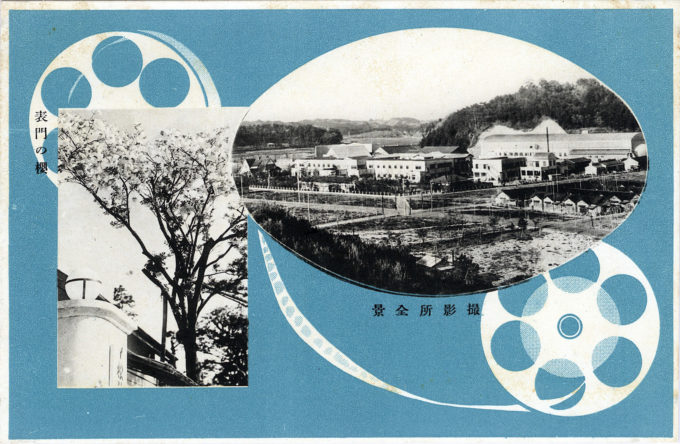“Toho Studios began as the Tokyo-Takarazuka Motion Picture Company, a business created in 1932 by railroad entrepreneur and visionary Kobayashi Ichizo for the purpose of [filming] stage theatre and exhibiting other cinematic productions.
“In Tokyo, the company operated both the Takarazuka Theatre (where it staged its famed Takarazuka all-girl revues) and the Hibiya Cinema, along with several other entertainment venues in the Marunouchi and Yurakucho districts of Tokyo.
“In 1936, Koyabashi also established the Toho Film Distribution Co. (combining the first kanji of “Tokyo” (東, ‘tou’ ko-yomi reading; and “Takarazuka” 宝 ‘hou’ ko-yomi reading, to form the name) to facilitate its motion picture distributions. Toho then merged, in 1937, with two other studios, PCL and Jenkins Osawa Studio, to form Toho Studios.
“In 1943, the conglomeration was renamed Toho Co. Ltd.”
– The Japanese Cinema Book, edited by Fujiki Hideaki & Alistar Phillips, 2020

Tokyo-Takazaruka Eiga K.K. (Tokyo-Takarazuka Motion Picture Co.) studio, Takarazuka, c. 1938. The company was founded in 1932 by railroad entrepreneur and visionary Kobayashi Ichizo as another component of the expanding popularity of his Takarazuka Revue. Photo insets, left to right: Main building entry; Filming stage; Film processing building. Through acquisitions and mergers, the film company would eventually evolve into the famous Toho Studios.
See also:
Takarazuka Revue, “Parisette”, c. 1930.
Takarazuka Gekijo (Theater), Tokyo
Takarazuka Hotel, Takarazuka Baths & the Takarazuka Grand Theatre, Takarazuka, c. 1920-1930.
Toei Kyoto Movie Studios, Kyoto, c. 1960.
“The year 1912 ushered in a new epoch in the history of Japan’s filmdom. Four film producing firms – Yoshizawa Shokai, M. Pathé, Hukuhodo and Yokota Shokai – which had hitherto been struggling for supremacy became merged into one large company called Nippon Katsudo-Shashin K.K., better known as Nikkatsu.
“… The success of the Nikkatsu stimulated emulation and effort. As a result, many a minor film producing companies sprang into existence. But none of them was equal to the Nikkatsu in capital. In 1920, however, a giant stepped into the arena. The gladiator was Shochiku Kinema Gomei K.K. Thus began the acute rivalry between these two major film producers.”
– “Japan’s Filmdom, Past and Present”, by Tsuneo Hazumi, Travel in Japan, Vol. 6 No. 4, 1941

Tokyo-Takarazuka Motion Picture Co., Takarazuka, c. 1938. Photo insets, left to right: Actor’s section courtyard; main recording room; distant view of the large stage building.
“Moving pictures, however, were not an entirely new experience for the Japanese because of their rich tradition of pre-cinematic devices such as gentō (utsushi-e) or the magic lantern. The kinetoscope, first shown commercially by Thomas Edison in the United States in 1894, was first shown in Japan in November 1896. The Vitascope and the Lumière Brothers’ Cinematograph were first presented in Japan in early 1897. The first successful Japanese-made film in late 1897 showed sights in Tokyo.
“At the dawn of the twentieth century theaters in Japan hired benshi, storytellers who sat next to the screen and narrated silent movies. They were descendants of kabuki jōruri, kōdan storytellers, theater barkers and other forms of oral storytelling. In 1908, Shōzō Makino, considered the pioneering director of Japanese film, began his influential career with Honnōji gassen [‘Honnoji War‘], produced for Yokota Shōkai. Shōzō recruited Matsunosuke Onoe, a former kabuki actor, to star in his productions. Onoe became Japan’s first film star, appearing in over 1,000 films, mostly shorts, between 1909 and 1926. The pair pioneered the jidaigeki [‘period dramas’] genre.
“The first Japanese film production studio was built in 1909 by the Yoshizawa Shōten company in Tokyo. Originally involved in the magic lantern business, Yoshizawa bought a cinématographe camera off a visiting Italian and began exhibiting motion pictures in 1897. Yoshizawa soon became the most prosperous and stable of the early film companies. It was the first to manufacture motion picture equipment domestically in 1900 and it established the first permanent movie theater, the Denkikan, in Asakusa in Tokyo in 1903.”
– Wikipedia


